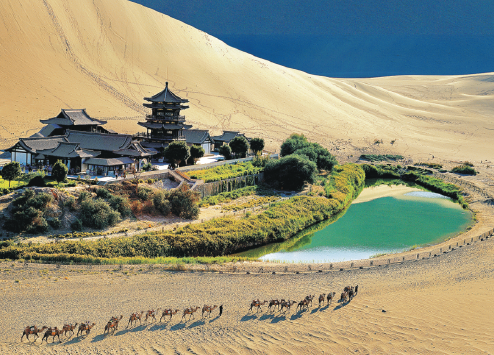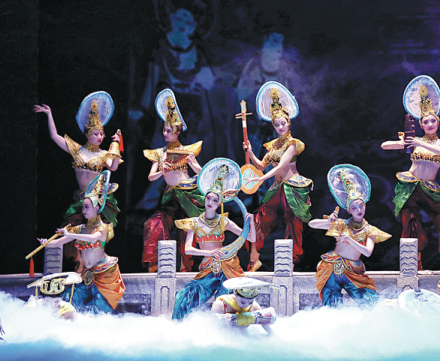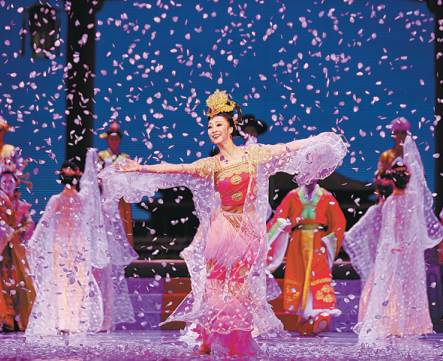Province situated along ancient Silk Road to expand lucrative industries
Tourism and culture to become key growth drivers in Gansu
The government of Gansu province is stepping up its efforts to boost the tourism and cultural industry during the 14th Five-Year Plan (2021-26), in the hope of spurring regional growth and reinforcing Dunhuang culture.
Gansu was once an important trade, transport and civilization hub along the ancient Silk Road in Northwest China. It boasts vast amounts of historical heritage and traditional artworks including seven world natural and cultural heritage sites recognized by the United Nations Educational, Scientific and Cultural Organization, more than 150 national-level cultural relic protection sites and more than 160,000 valuable cultural relics. The famous heritage sites including the Mogao Grottoes, one of the greatest repositories of ancient Buddhist art, dating back to the 4th century in Dunhuang, and the Jiayuguan Pass, which is a famed part of the Great Wall of the Ming Dynasty (1368-1644) in the city of Jiayuguan.
The region wows global visitors with its stunning natural beauty. Iconic places include the Danxia National Geological Park in Zhangye, where mountains in the area are flush with a variety of colors such as red, yellow, orange, green, white, graphite, dark gray and off-white. Other iconic sites include the Yueya Spring in Dunhuang, which is a crescent-shaped spring-fed lake surrounded by desert, and the Kongtong Mountain in Pingliang, known for its long history of Taoist culture in China.
"Gansu has all the landforms in the world except oceans and islands," said Chen Weizhong, director of the Gansu Culture and Tourism Bureau. "Gansu ranks fifth in China for the richness of its cultural and tourism resources, which is an indication of its strong soft power."
According to Chen, tourism scenic spots in Gansu received a combined 1.32 billion visits during the 13th Five-Year Plan (2016-20), an increase of 24 percent from the 12th Five-Year Plan (2011-15). Total tourism income reached 899.5 billion yuan ($139.7 billion), an increase of 30 percent from the 12th Five-Year Plan. The cultural and tourism industries ranked first among 10 ecological-centered industries in terms of combined income in Gansu between 2016 and 2020.
Dunhuang, a county-level city, was an important outpost and a bustling oasis on the ancient Silk Road. The culture in the area features an integration of Chinese culture and different civilizations.
Historian Ji Xianlin (1911-2009) commented in 1986 that Dunhuang is one of the few areas in China that integrates Chinese, Indian, Greek and Islamic culture.
The Mogao Grottoes in the city contribute greatly to Dunhuang's unique culture. The grottoes, one of the world's largest sites of Buddhist art, boast 45,000 square meters of murals in 735 cliff caves and more than 3,000 sculptures. Researchers have so far found more than 50,000 sutras, documents and paintings in the "cave for preserving Buddhist scriptures". At the Xuanquanzhi relic site, more than 35,000 bamboo slips from various dynasties have been discovered.
Strengthening protection
Since the early 1990s, researchers in Gansu have been embracing technology to protect and document heritage relics. Digitalization is among a variety of technologies they're using to facilitate protection and the passing down of ancient cultural treasures.
The Dunhuang Academy, a research institution responsible for carrying out heritage research and protection work in Dunhuang, has collected accurate images and data related to 229 grottoes and processed images from 156 of them. In addition, 143 grottoes were restored structurally by 2020, according to the academy.
The academy has also partnered with leading Chinese technology companies such as Tencent and Huawei to ensure the most cutting-edge technologies can be employed in protection and cultural promotion works.
The Gansu government has unveiled construction plans for the Dunhuang Cultural Heritage Protection, Inheritance and Innovation Center, and the National Cultural Heritage Protection Center and Mogao Grottoes Tourists Service and Experience Center in hopes of strengthening protection and helping people learn more about the Mogao Grottoes.
Apart from Dunhuang, protection work is also being carried out in other regions in Gansu. A recent restoration project is the Mati Temple, with a history of 1,600 years in Zhangye. The temple is a national key cultural relic protection site.
According to Xinhua News Agency, the work will focus on one of the site's major attractions called the Thousand Buddha Grottoes, which has eight caves that are among the best-preserved across the entire site. The project is scheduled to be completed in 2022.
Gansu began to implement a provincial-level regulation on the protection of the Gansu section of the Great Wall in July 2019, becoming the first among 15 provinces which have sections of the Great Wall to do so.
Network of city tourism
The Gansu government will take advantage of its rich cultural and natural resources in cities such as Lanzhou, Jiuquan and Jiayuguan to develop its tourism industry. It plans to develop a complete industrial chain to achieve high-quality development during the 14th Five-Year Plan.
Railway networks will be further expanded so visitors can reach tourism destinations more conveniently. Flight routes linking cities such Hangzhou in Zhejiang province and Nanjing in Jiangsu province have been launched and will be expanded, according to the government.
According to Chen of Gansu Culture and Tourism Bureau, efforts will be made to attract tourists from the Beijing-Tianjin-Hebei region, the Pearl River Delta, the Guangdong-Hong Kong-Macao Greater Bay Area, Southwest Asia, and Central and West Asia.
Online channels will be developed so the next generation can learn more about the province with greater ease and convenience.

From left: Horses gallop around the Shandan Horse Farm, one of the oldest horse ranches in Gansu. The Yellow River, the second-longest river in China, meanders through a wetland in Gansu. Mountains in the Danxia National Geological Park in Zhangye exhibit a variety of colors. CHINA DAILY

The Yueya Spring is a crescent-shaped lake 6 kilometers south of the city of Dunhuang in Gansu province. CHINA DAILY

Artists stage the classic Chinese drama Flower Rains Along Silk Road, a spectacular set of folk dances first performed in 1979. CHINA DAILY

Artists stage the classic Chinese drama Flower Rains Along Silk Road, a spectacular set of folk dances first performed in 1979. CHINA DAILY





 Print
Print Mail
Mail
